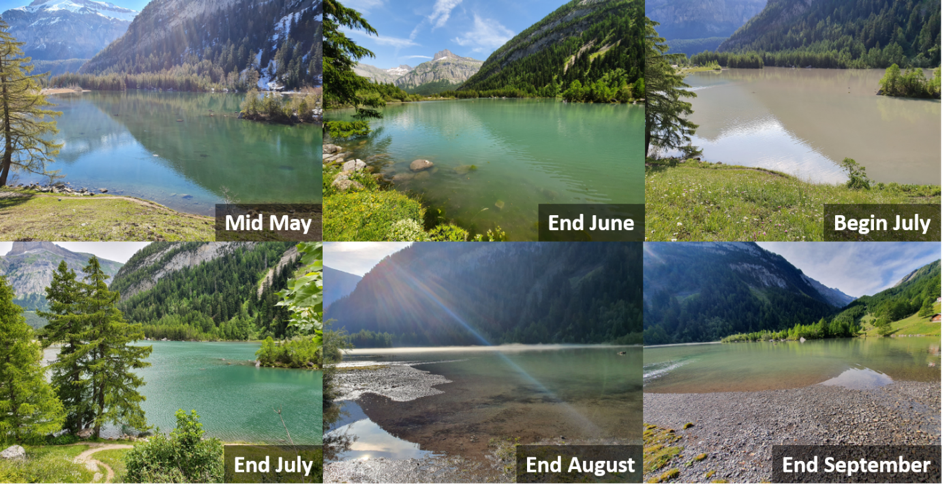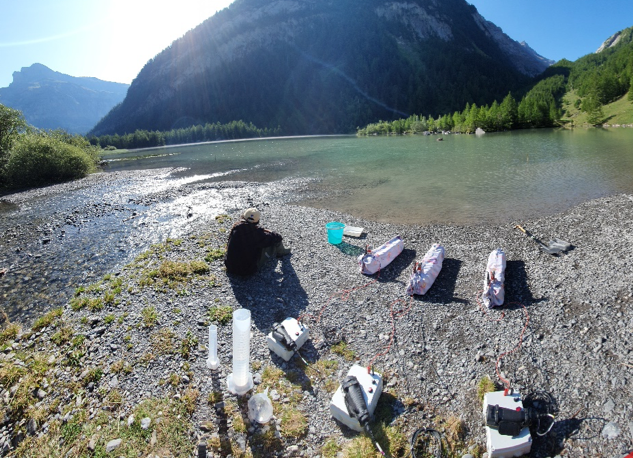Collaborator: Janine Rüegg
A project in collaboration between the groups AlpWISE and LAKES of Idyst groups and the CIRM (UNIL at Sion)
Freshwater ecosystems are hotspots of biodiversity and provide critical services to society, since humans rely on lakes, streams, and groundwater for much of their freshwater supply. Freshwaters are generally separated into lotic (i.e., flowing water, e.g., streams) and lentic (i.e., still water; e.g., lakes) ecosystems, both of which have been proposed as sentinels of environmental change. Despite the clear connection between the two aquatic ecosystems, as lakes are generally fed by tributary streams and lakes alter the conditions of the stream along its continuum, the study of lakes and streams is rarely combined. Direct study of lentic-lotic linkages, both in terms of the transition zones and the freshwater continuum (i.e., stream-lake-stream interactions) is needed to better understand the freshwater aquatic ecosystem. In fact, water resource management and protection of aquatic ecosystems is mostly based on river basins that include various freshwater bodies, be they streams, rivers, or lakes, and requires thinking about freshwater ecosystems at a more integrated level, including the consideration of physical, chemical and biological properties. To enable integration across disciplines and understanding of the interplay between catchment, lakes, and streams for management, conservation and restoration, this project argues that understanding lotic-lentic transition zones in terms of the physical, chemical and biological dimensions is a first key step, followed by an understanding of how a lake impacts the stream continuum from inlet to outlet.

We are currently conducting a pilot study on the freshwater continuum at Lac Derborence (VS). To study freshwater transition zones, we focus on the inlet transition zones, namely those where the Chevilleince and the Derbonne streams enter Lac Derborence. At both inlets, we select nine littoral locations that traverse the inlet delta, starting outside the influence of the stream, passing through the entry of the stream flow and ending outside the stream influences on the other side, while keeping the depth at which samples are collected constant at about 50 cm. Additionally, we also sample three locations in each of the inlet streams above the lake. To really understand the transition zone and determine if the environment and biota vary along the gradient of stream influence we measure physical (flow velocity, water temperature, dissolved oxygen, and conductivity) and chemical properties (dissolved organic carbon, phosphorous, nitrogen, suspended solids), sample for benthic (i.e., associated with the sediments) structure, such as biofilm (i.e., algae, fungi and bacteria growing on submerged surfaces) biomass and macroinvertebrate (e.g., insect larvae, different types of worms) biomass and diversity, and function in the form of sediment metabolism (i.e., production, respiration).

To study the stream-lake-stream continuum at the larger scale, we deployed automated sensors in the two inflowing streams, the lake and two locations in the outflowing stream (one just below the outflow and one further downstream. These sensors will allow us to calculate different metrics to start formulating the concept of when and how the lake changes the expected downstream continuum, and how far downstream such changes might persist. We will approximate lake water residence time through knowledge of water inputs from streams, lake water level, and outflowing water volume. The sensors also provide us with stream temperature and dissolved oxygen, which we will use to calculate ecosystem metabolism in both of the inflowing streams, the lake and the outflowing stream. Comparing temporal patterns of metabolism to dynamics of water residence time, will provide a first step toward our understanding of the lotic-lentic-lentic continuum.
